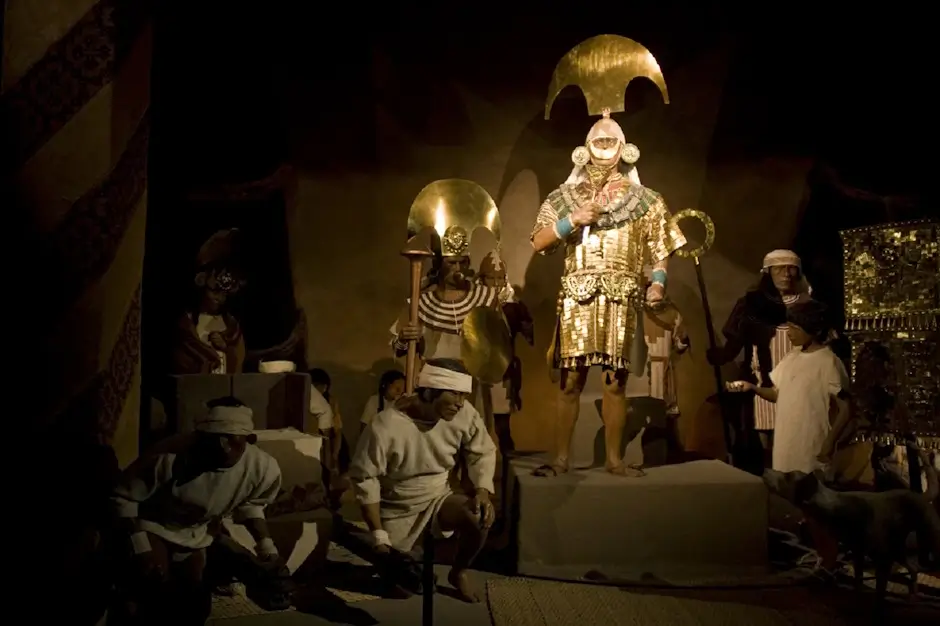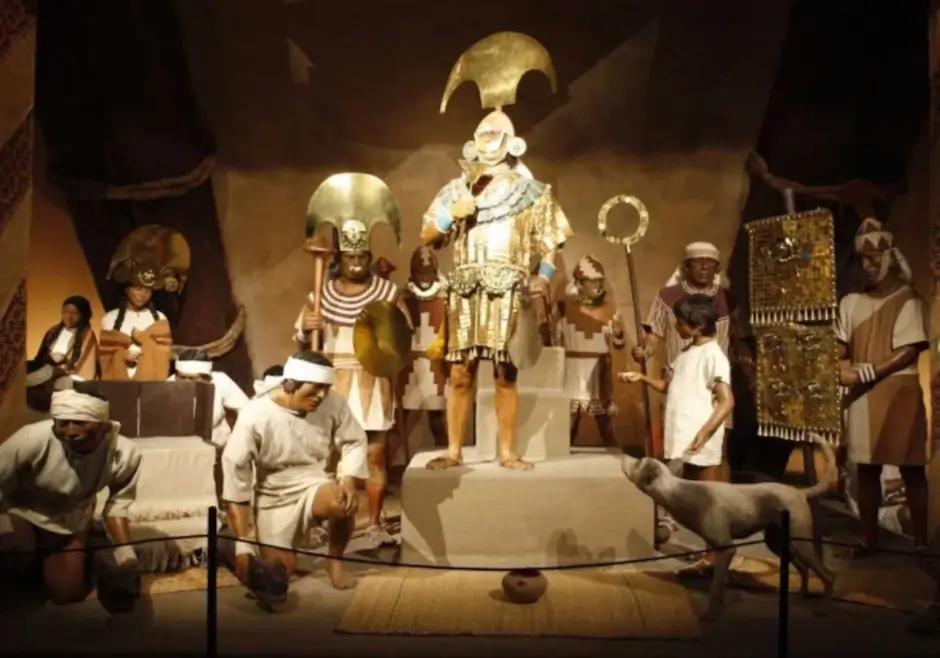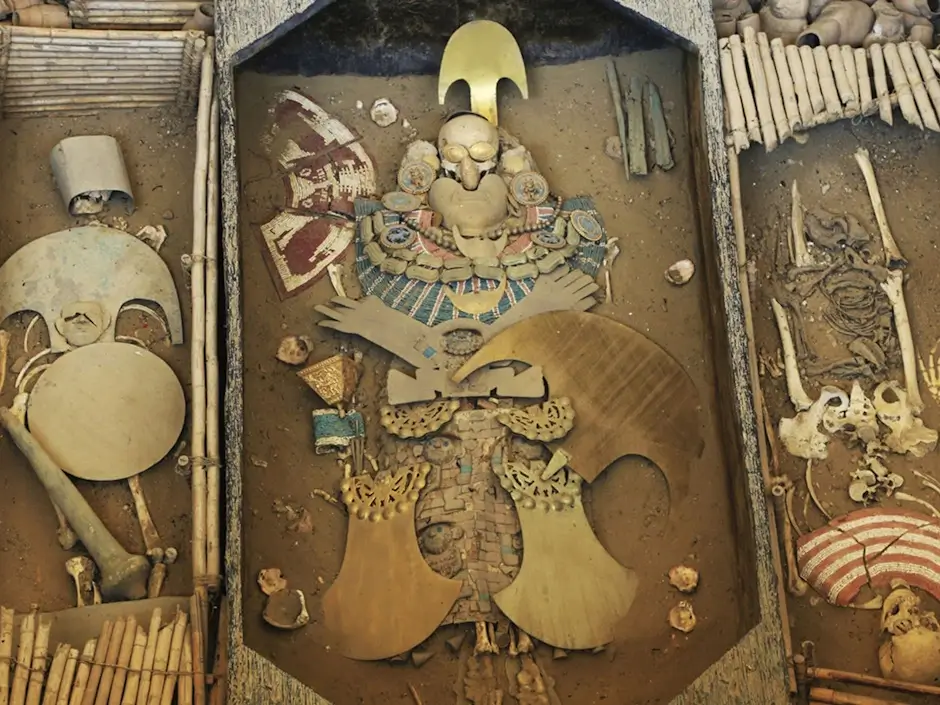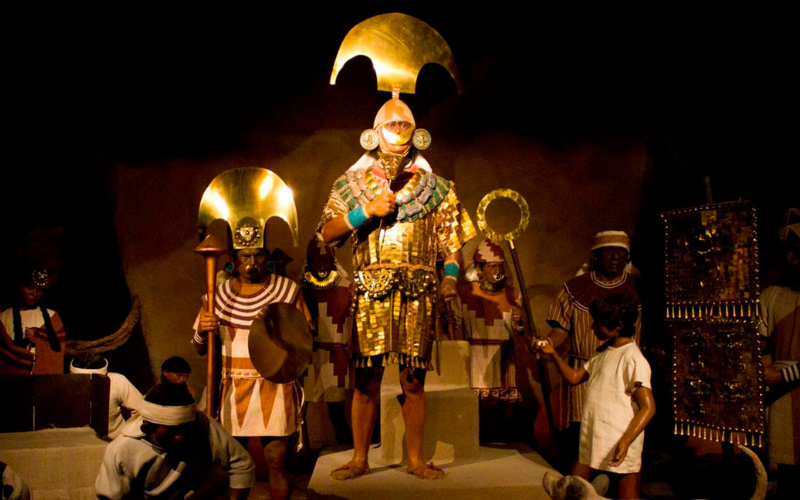The Enigmatic Legacy of the Lord of Sipán
Enigmatic Lord of Sipán, a prominent figure from ancient Peru, holds a unique place in history as one of the most significant archaeological discoveries of the 20th century. Unearthed in the northern region of Peru, the Lord of Sipán’s tomb revealed a treasure trove of artifacts and provided invaluable insights into the Moche civilization. The tomb of the Lord of Sipán, often dubbed the “Tutankhamun of the Americas,” unveiled secrets long buried beneath the sands of time and transformed our understanding of the Moche culture — one of Peru’s most sophisticated pre-Inca civilizations.
- Embark on a Journey of Ancient Traditions: The Inti Raymi Tour in Cusco 4 Days
- Discover the Wonders of Peru with the Tour Perú Machu Picchu 5 Days
- Discover Peru with the City Tour Sacred Valley Machu Picchu 4 Days
- Explore the Wonders of Cusco with City Tour and Machu Picchu3 Days
The Lord of Sipán: A Royal Tomb Untouched by Time
In the heart of northern Peru’s arid landscape, one of the most extraordinary archaeological discoveries in the Americas took place in 1987 — the royal tomb of the Lord of Sipán. Found intact, untouched by grave robbers or time, this ancient burial site revealed the extraordinary sophistication and splendor of the Moche civilization. It was a moment that reshaped our understanding of pre-Columbian cultures and offered a priceless glimpse into a forgotten world.
A Once-in-a-Lifetime Discovery
The tomb was uncovered at Huaca Rajada, near the town of Sipán in the Lambayeque region, by Peruvian archaeologist Dr. Walter Alva and his team. To their astonishment, they found the burial chamber completely preserved — a rarity in Latin American archaeology, where many sites have been looted.
Inside the tomb lay the remains of a Moche ruler who lived around 250 AD. He was richly adorned with gold, silver, copper ornaments, semiprecious stones, and intricate jewelry. The tomb was so lavish that many have compared it to the tomb of Tutankhamun in Egypt, earning the Lord of Sipán the nickname “The King Tut of the Americas.”
Treasures of a Lost Civilization
The burial site contained not only extraordinary artifacts but also human and animal companions. Alongside the Lord’s body were the remains of a warrior, a child, a woman, and even a dog — all believed to have been sacrificed to accompany him in the afterlife. Each figure had a precise role and placement, reflecting the highly ritualized and hierarchical nature of Moche society.
Some of the most remarkable items included:
- Golden necklaces shaped like peanuts, symbolizing fertility and duality.
- Earspools and pectorals representing power, wisdom, and connection to the divine.
- Ceremonial weapons made of precious metals, indicating the Lord’s dual role as a warrior and priest.
Preserving History
The discovery not only shed light on the power and complexity of Moche culture but also marked a turning point in the preservation of Peru’s archaeological heritage. In response to the discovery, the Royal Tombs of Sipán Museum was built in Lambayeque. This state-of-the-art museum now houses many of the original artifacts and offers an immersive experience for visitors interested in Peru’s rich pre-Inca history.
A Testament to Eternal Majesty
The Lord of Sipán’s tomb remains one of the most complete and untouched royal burials ever found in the Americas. It provides archaeologists and historians with invaluable information about social structure, beliefs, funerary practices, and artistry in ancient Peru. More importantly, it connects modern Peruvians with their ancestral legacy, showcasing the greatness of a civilization that thrived long before the Incas.
Symbols of Power and Divinity of the Lord of Sipán
The discovery of the Lord of Sipán in 1987 did more than unearth a royal tomb — it revealed a treasure trove of sacred objects and ceremonial regalia that spoke volumes about ancient beliefs, leadership, and the divine authority of the Moche elite. Buried with opulence and intention, the Lord’s adornments were far more than displays of wealth; they were powerful symbols of his role as both ruler and spiritual intermediary.
A Portrait in Gold and Symbolism
The Lord of Sipán was adorned in exquisite jewelry and elaborate garments crafted from gold, silver, copper, semi-precious stones, and marine shells. Each item had deep meaning in Moche society:
- Earspools: Large, intricate ear ornaments represented status, wisdom, and the ability to hear the gods. Worn by high-ranking individuals, they emphasized the Lord’s elevated position in both the earthly and spiritual realms.
- Pectorals: The Lord wore massive chest plates, often crescent-shaped and made of gold or gilded copper. These were not only decorative but also symbolized the sun, a central element in Andean cosmology, and the divine light that empowered rulers.
- Necklaces of golden peanuts: One of the most fascinating items in the tomb was a necklace made of gold and silver peanuts. Gold represented the masculine and the sun, silver the feminine and the moon — together, they expressed duality and balance, essential principles in Moche cosmology and governance.
- Headdress and diadem: His regal headdress, adorned with feathers and metalwork, signified authority and a connection to divine power. It elevated the Lord visually and symbolically, transforming him into a semi-divine figure during rituals and ceremonies.
The Warrior-Priest Identity
The Moche elite often played dual roles as both warriors and priests. This duality is reflected in the regalia buried with the Lord of Sipán. He was buried with:
- Ceremonial weapons: Including ornate clubs and spears, these tools symbolized strength and protection. They were not necessarily used in combat but served as emblems of leadership and ritual power.
- Sacrificial symbols: Items related to human sacrifice, such as ceremonial knives (tumi), indicated his role in religious ceremonies, possibly as the one who enacted or oversaw sacred rites.
The Divine Right to Rule
In Moche culture, rulers were seen as chosen by the gods or even as living embodiments of divine forces. The artistic depictions found on Moche ceramics often show a figure known as the “Warrior Priest” — a figure many believe to represent the Lord of Sipán himself, engaging in ceremonies, receiving offerings, and interacting with mythological beings.
His burial context, with multiple human and animal sacrifices, reinforced his divine status. The placement of guards and companions, as well as the layers of offerings, suggest a journey into the afterlife worthy only of one with divine approval.
Eternal Power, Preserved in Time
More than 1,700 years later, the symbols of the Lord of Sipán continue to inspire awe and fascination. They offer not only a glimpse into the hierarchy and rituals of the Moche civilization but also a deeper understanding of how ancient cultures expressed identity, cosmology, and divine connection through material culture.
- Discover Peru with the City Tour Sacred Valley Machu Picchu 4 Days
- Cusco Travel with City Tour and tour Machu Picchu 2 Days
- Tour Machupicchu full day in Train Full Day
The Lord of Sipán: Symbols of Power and Divinity
The discovery of the Lord of Sipán in 1987 not only amazed the archaeological world but also revealed a universe of symbols deeply embedded in power, religion, and identity. The tomb of this Moche ruler, buried around 250 AD in northern Peru, was more than a resting place — it was a sacred stage where objects, colors, and forms conveyed the divine status of a man revered as both king and living deity.
A Message Written in Gold and Silver
Found intact at Huaca Rajada, the Lord of Sipán’s burial chamber held an astonishing array of ceremonial objects crafted in gold, silver, copper, shells, and semi-precious stones. These were not mere treasures. Each item served as a visual language that expressed authority, religious function, and the connection between the earthly and spiritual realms.
Key Symbols of Divine Authority:
- The Headdress and Diadem: Towering and adorned with feathers and gold, his headdress marked him as a sacred figure. In Moche iconography, such headpieces were worn by gods and priests during major rituals.
- The Gold-Silver Peanut Necklace: One of the most iconic items, this necklace included 10 gold and 10 silver peanuts. Gold symbolized the sun and masculinity, silver the moon and femininity — reflecting the Moche belief in cosmic duality and balance, essential to ruling with divine harmony.
- Pectorals and Chest Ornaments: The Lord’s chest was covered with crescent-shaped pectorals, echoing the symbol of the moon and suggesting his alignment with celestial power.
- Earspools: Oversized ear ornaments were emblems of wisdom and status. In Moche culture, only the elite could “hear the gods,” and these earspools declared that the Lord of Sipán was a conduit between heaven and earth.
- Ceremonial Weapons: Ornate maces, spears, and shields found in the tomb pointed to his role as a warrior-priest. While symbolic, they reinforced his strength in both the battlefield and spiritual leadership.
The Warrior Priest Archetype
Moche ceramics often depict a central religious figure — richly dressed, holding a tumi (ceremonial knife), and surrounded by warriors and priests. Scholars believe this figure may represent the historical Lord of Sipán or his mythologized role as a semi-divine mediator. His regalia matched these depictions almost exactly, suggesting that the Lord of Sipán was both a real and symbolic figure, embodying the ideals of leadership, sacrifice, and cosmic order.
The Divine Right to Rule
The elaborate funerary context of the Lord of Sipán — including human and animal sacrifices buried alongside him — reflects a belief in the ruler’s divine right and sacred destiny. Those who accompanied him in death were not merely servants but participants in a spiritual passage that elevated his soul to the realm of the gods.
In Moche cosmology, death was not an end but a transformation. The objects buried with the Lord were tools for this journey — keys to another dimension, affirming his divine nature and eternal role as protector of his people.
Legacy in Gold
Today, the Lord of Sipán stands as one of the most powerful archaeological symbols of ancient Peru. His image — adorned with golden regalia — is a lasting reminder of how art, religion, and power converged in the Moche world. Through these symbols, the Lord continues to reign in memory, a golden shadow of divine authority frozen in time.
The Lord of Sipán: Legacy and Impact
In 1987, the discovery of the tomb of the Lord of Sipán in northern Peru stunned the world. For the first time in the Americas, archaeologists had uncovered an unlooted royal burial site belonging to a pre-Columbian civilization: the Moche. Rich in symbolism, gold, and cultural meaning, the tomb offered a rare window into the grandeur of ancient Andean societies. But beyond the treasure and headlines, the true value of this discovery lies in its enduring legacy and impact — on archaeology, national identity, and global understanding of Peru’s past.
A Turning Point in Peruvian Archaeology
Before the tomb of the Lord of Sipán was found, many believed that only the Inca Empire had left behind significant architectural and cultural achievements in Peru. The Sipán discovery changed this narrative forever. It revealed that the Moche civilization (circa 100–800 AD) possessed advanced metallurgical techniques, social organization, and religious complexity long before the Incas rose to power.
This tomb gave archaeologists a complete context — from human sacrifices and grave goods to ceremonial attire and architecture. It allowed researchers to reconstruct Moche society in unprecedented detail and encouraged new excavations in other parts of the northern coast, further expanding our knowledge of ancient Peru.
National Pride and Cultural Identity
The Lord of Sipán became a national icon in Peru. His image, regalia, and story were embraced not just by scholars, but by everyday Peruvians as a source of cultural pride. The discovery inspired a renewed interest in pre-Inca heritage, helping to redefine national identity around a broader and more inclusive historical narrative.
In response to the international significance of the find, the Peruvian government built the Royal Tombs of Sipán Museum in Lambayeque — an architectural masterpiece that resembles the Moche pyramids and houses the recovered artifacts. The museum has become one of the most visited cultural institutions in South America, attracting thousands of local and international tourists each year.
Global Recognition and Academic Impact
The Sipán tomb gained international acclaim and has been featured in major exhibitions across Europe, North America, and Asia. It placed the Moche civilization on the global archaeological map, inviting comparisons with Egypt’s Valley of the Kings and the tomb of Tutankhamun.
Moreover, it advanced the field of Andean studies. Archaeologists and historians began to view ancient Peruvian societies as more complex and regionally diverse than previously thought. The interdisciplinary work surrounding the tomb — involving bioarchaeology, metallurgy, and iconography — set new standards for archaeological practice in Latin America.
Legacy for Future Generations
The Lord of Sipán has become a bridge between past and present. His tomb, and everything it represents, continues to inspire students, artists, filmmakers, and researchers. Through documentaries, museum tours, and educational programs, his story lives on — not only as a tale of ancient glory, but also as a reminder of the importance of preserving heritage in a rapidly changing world.
The discovery has also underscored the need to combat looting and illicit trafficking of cultural artifacts. It demonstrated that when preserved and studied properly, archaeological treasures can enrich the cultural and scientific life of an entire nation.
The Lord of Sipán: A Window into a Millennial Past
In the arid lands of northern Peru, beneath the ancient sands of Huaca Rajada, a door to the past was opened in 1987 — a discovery that would forever change the understanding of South America’s pre-Columbian history. The tomb of the Lord of Sipán, a ruler of the Moche civilization, emerged as one of the most important archaeological finds of the 20th century. Rich in symbolism, splendor, and ritual, his burial site has become a powerful window into a millennial past, offering unparalleled insight into a world that flourished long before the rise of the Inca Empire.
Rediscovering a Lost Civilization
The Moche culture thrived between 100 and 800 AD along Peru’s northern coast. For centuries, their legacy remained partially hidden — known mostly through elaborate ceramics and ruined temples. But the discovery of the Lord of Sipán’s intact royal tomb changed everything.
Unlike many ancient burials, which had been looted over time, this tomb remained untouched for nearly 1,700 years. It preserved not only gold and jewels, but also human remains, ceremonial garments, and religious artifacts that told the story of a powerful and theocratic society.
A Life Written in Symbols
The Lord of Sipán was buried with extraordinary treasures — gold pectorals, silver earrings, elaborate necklaces, feathered headdresses, and ceremonial weapons. Each object had meaning. These items revealed that he was more than a ruler: he was seen as a divine intermediary between the gods and his people.
Through the tomb’s contents, archaeologists were able to reconstruct Moche religious beliefs, class structures, and burial customs. The presence of accompanying individuals — warriors, servants, and even a child — suggested ritual sacrifice and a strong belief in the afterlife.
A Bridge Between Eras
The impact of the discovery went far beyond the scientific community. The Lord of Sipán became a symbol of national pride in Peru and a bridge between modern Peruvians and their ancient ancestors. His story inspired museums, documentaries, art, and education — reconnecting people with a past that was rich, complex, and uniquely Peruvian.
The Royal Tombs of Sipán Museum in Lambayeque now houses the archaeological treasures in a modern structure inspired by Moche pyramids. Thousands of visitors each year stand in awe before the artifacts, rediscovering a culture that was once at risk of being forgotten.
Lessons from the Ancient World
The Lord of Sipán’s tomb offers more than a glimpse into the splendor of a past civilization — it reminds us of the fragility and richness of cultural memory. The preservation of this site teaches the importance of protecting archaeological heritage, fighting against looting, and valuing the knowledge that ancient cultures can offer modern society.
It also underscores the universality of human experience: the desire for meaning, the need for leadership, the reverence for life and death, and the search for transcendence.
The enigmatic Lord of Sipán stands as a powerful testament to the brilliance and mystery of ancient Peru. As archaeologists continue to decode his legacy, each discovery adds a new verse to the epic poem of South America’s pre-Columbian civilizations. For travelers and scholars alike, his story is an invitation to explore, to question, and to marvel.
- Discover the Wonders of Peru: with the Tour Perú Machu Picchu Nazca 15 Days
- Discover the Best of Perú: with the Tour Perú Amazon Nazca Machu Picchu 20 Days
- Travel Package to Peru Tour in Lima, Paracas, Ballestas, Nazca Lines, Colca Canyon 22 Days
visit Leading Peru Travel. Follow us on Instagram to see photos and updates from our trekking adventures. Start planning your hiking adventure now and contact us through WhatsApp! Enjoy your trip! contact us on WhatsApp
CONTACT US:
We are a Travel Agency specialized in tourist packages, if you need any information, do not hesitate to write to us.
We offer tours in Peru and Bolivia.




